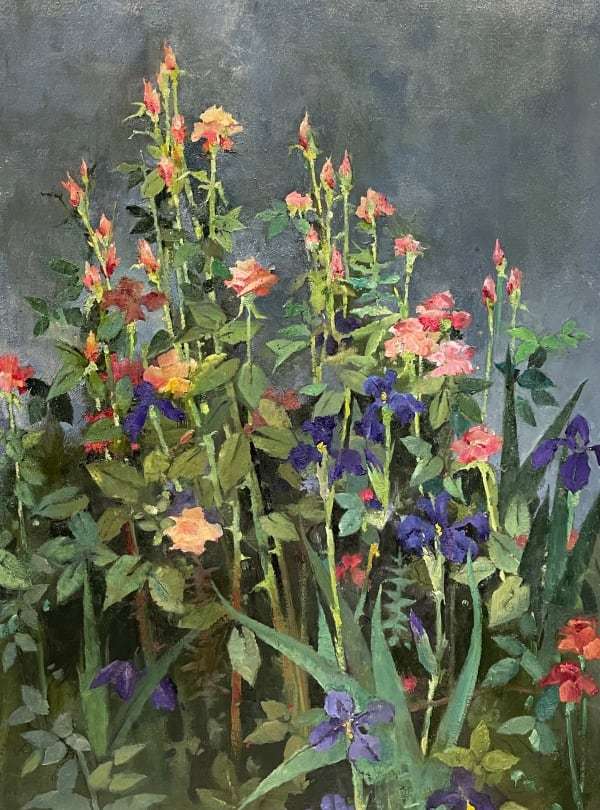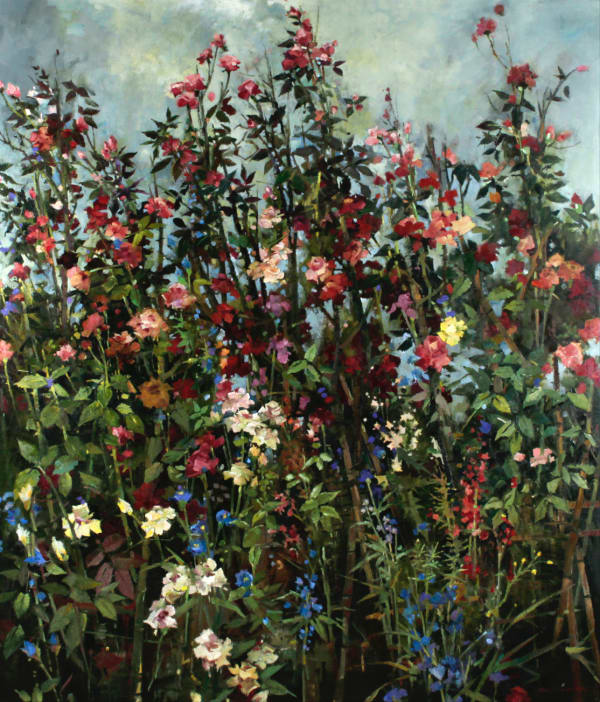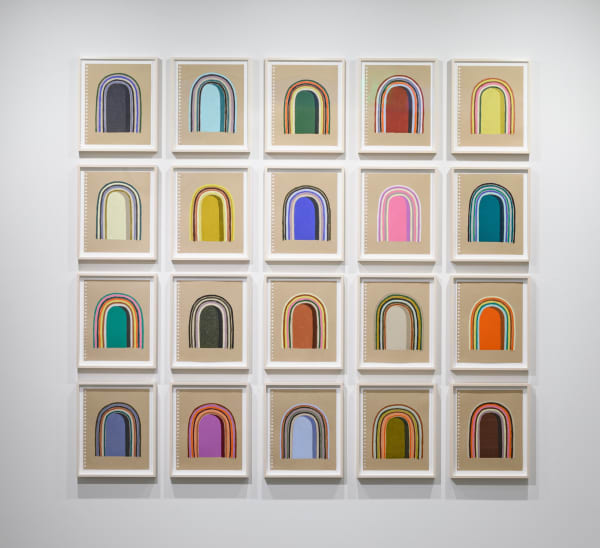John Alexander American, b. 1945
-
-
Biography
John Alexander (b. 1945, Beaumont, TX) received his B.F.A. from Lamar University in Beaumont in 1968 and his M.F.A. from Southern Methodist University in Dallas in 1970. Following graduate school, Alexander taught at the University of Houston and today divides his time between his SoHo studio loft and his home in Amagansett, East Hampton. As an undergraduate majoring in applied arts at Lamar, Alexander was influenced by professor and friend Jerry Newman, whose courses emphasized academic training in drawing, painting, and art history. A skilled draftsman himself, Newman encouraged his students to develop a firm foundation in still-life drawing and to copy sketches by such masters as Leonardo da Vinci—rigorous formal training that is still evident in Alexander’s work.
Growing up with camping and fishing trips in the bayous and woods of East Texas, Alexander developed a deep connection to the natural world. His lush paintings, populated with diverse flora and fauna, reflect both his reverence for the tradition of landscape painting—as practiced by Monet and the Hudson River School painters—and his father’s influence as an avid environmentalist attuned to the damage caused by industry and pollution. While his subject matter may appear bucolic, the energy of his brushwork, symbolic imagery, and psychological undertones convey a complex vision. Exoticism and beauty are balanced with an introspective awareness, creating vivid, idiosyncratic expressions of an artist for whom everything in nature holds meaning. His work has been widely exhibited across leading American museums and international galleries.
-
Selected Public Collections & Honors
The Metropolitan Museum of Art, New York
Smithsonian American Art Museum, Washington, DC
Museum of Fine Arts, Houston (MFAH)
Museum of Contemporary Art, Los Angeles
Los Angeles County Museum of Art (LACMA)
Hirshhorn Museum and Sculpture Garden, Washington, DC
Dallas Museum of Art, Dallas
Modern Art Museum of Fort Worth, Fort Worth
Museum of Contemporary Art Chicago, Chicago
Nelson-Atkins Museum of Art, Kansas City
Museum of Contemporary Art San Diego, San Diego
National Endowment for the Arts Fellowship (1981)
Guggenheim Fellowship for Creative Arts (1984)
Retrospective: Smithsonian American Art Museum & MFAH (2007)
Crystal Head Vodka bottle design, co-created with Dan Aykroyd (2007) -
-
-
Exhibitions
-
-

Editions and Works on Paper
January 15 – March 5, 2026 -

55 Years
Isn't That Long Enough? June 26 – August 14, 2025Featuring paintings, works on paper, sculpture, film, and archival ephemera from the SFMOMA Library, and SFAI archive, this ambitious exhibition showcases museum-quality works by contemporary and historical artists, illustrating Berggruen... -

Works on Paper
March 7 – April 25, 2024 -

Her Voice
An Exhibition in Honor of Gretchen Berggruen November 10 – December 23, 2022I am honored to present this exhibition, Her Voice, in honor of my late wife, Gretchen Berggruen. Co-owner of Berggruen Gallery, Gretchen was the heart and soul of the gallery.... -

Berggruen Gallery in East Hampton
55 Main Street East Hampton, NY 11937 May 14 – September 12, 2021Berggruen Gallery is pleased to announce the opening of an exhibition space in East Hampton for the 2021 summer season. The gallery space is located in the heart of East... -

Selected Contemporary Paintings and Works on Paper
February 28 – May 11, 2019
-
-
Art Fairs
-

Art Basel Miami Beach
Miami Beach, Florida Dec 4 – 7, 2025Berggruen Gallery is delighted to participate in the 2025 edition of Art Basel Miami Beach. 2025 marks Berggruen Gallery’s twenty-third consecutive year participating in ABMB,...View More -

The San Francisco Fall Show
San Francisco, California Oct 15 – 19, 2025Berggruen Gallery is delighted to participate in the 2025 San Francisco Fall Show. Please visit us at The Festival Pavilion at The Fort Mason Center. Tickets are required for all show dates. Exhibiting artists to be announced.View More -

The Armory Show
New York City, New York Sep 4 – 7, 2025Berggruen Gallery is proud to participate in The Armory Show 2025. Please visit us at Booth 400 at the Javits Center in New York. Tickets...View More -

FOG Design + Art
San Francisco, California Jan 22 – 26, 2025View More -

Art Basel Miami Beach
Miami Beach, Florida Dec 4 – 9, 20242024 will mark Berggruen Gallery’s twenty-second consecutive year participating in Art Basel Miami Beach, since the fair’s inception.View More -

The San Francisco Fall Show
San Francisco, California Oct 16 – 20, 2024View More -

The Armory Show
New York City, New York Sep 5 – 8, 2024Berggruen Gallery is pleased to announce its participation in The Armory Show 2024. Please visit us at Booth 213 at the Javits Center in New...View More -

Dallas Art Fair
Dallas, Texas Apr 4 – 7, 2024View More -

FOG Design + Art
San Francisco, California Jan 18 – 21, 2024View More -

Art Basel Miami Beach
Miami Beach, Florida Dec 7 – 10, 2023View More -

ADAA The Art Show
New York City, New York Nov 2 – 5, 2023Berggruen Gallery is pleased to announce our 35th consecutive year of participation in The Art Show, organized by the Art Dealers Association of America (ADAA). Please visit us at Booth A15 at the Park Avenue Armory, New York. A preview gala benefiting the Henry Street Settlement will be held on Wednesday, November 1, 2023. The gallery is delighted to exhibit a solo presentation of work by American artist John Alexander. His lush paintings, populated with diverse flora and fauna, signal a reverence for the tradition of landscape painting as practiced by such art historical masters as Claude Monet or the more recent Hudson River School painters of the American northeast. The gallery will showcase a selection of Alexander’s most recent work. Benefit Preview: Wednesday, November 1, 2023 Show Dates & Times: Thursday, November 2, 2023, 12PM - 7PM Friday, November 3, 2023, 12PM - 7PM Saturday, November 4, 2023, 12PM - 7PM Sunday, November 5, 2023, 12PM - 5PM Location: Booth A15 Park Avenue Armory Park Avenue at 67th Street New York, NY 10065View More -

The San Francisco Fall Show
San Francisco, California Oct 11 – 15, 2023View More -

The Armory Show
New York City, New York Sep 7 – 10, 2023View More -
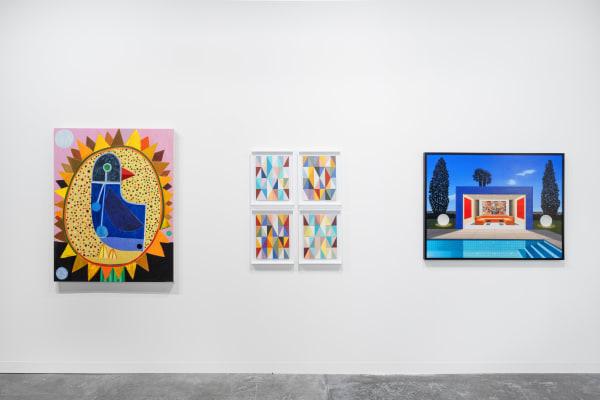
Art Basel Miami Beach
Miami Beach, Florida Nov 29 – Dec 3, 2022View More -

TEFAF
New York City, New York May 6 – 10, 2022View More -

Art Basel Miami Beach
Miami Beach, Florida Dec 2 – 4, 2021Berggruen Gallery is pleased to announce our participation in Art Basel Miami Beach. Please visit us at Booth D3 at the Miami Beach Convention Center.View More -

ADAA The Art Show
New York City, New York Nov 4 – 7, 2021Berggruen Gallery is pleased to announce its participation in The Art Show 2021 organized annually by the Art Dealers Association of America (ADAA). Please visit...View More -

ADAA The Art Show
New York City, New York Feb 27 – Mar 1, 2020Berggruen Gallery is pleased to announce its participation in The Art Show 2020 organized annually by the Art Dealers Association of America (ADAA). Please visit...View More -

FOG Design + Art
San Francisco, California Jan 16 – 19, 2020Berggruen Gallery is pleased to announce its participate in FOG Design+Art 2020. Please visit us at Booth 202 at the Fort Mason Center, Festival Pavilion,...View More -

Art Basel Miami Beach
Miami Beach, Florida Dec 5 – 8, 2019View More -

Dallas Art Fair
Dallas, Texas Apr 11 – 14, 2019Berggruen Gallery is pleased to announce its participation in Dallas Art Fair 2019. Please visit us at Booth A4 at Fashion Industry Gallery, Dallas. A...View More -

Art Basel Miami Beach
Miami Beach, Florida Dec 6 – 9, 2018Berggruen Gallery is pleased to announce our participation in Art Basel Miami Beach. Please visit us at Booth D5 at the Miami Beach Convention Center.View More -

Art Basel Miami Beach
Miami Beach, Florida Dec 7 – 10, 2017Berggruen Gallery is pleased to announce our participation in Art Basel Miami Beach. Please visit us at Booth B7 at the Miami Beach Convention Center....View More -

ADAA The Art Show
New York City, New York Mar 1 – 5, 2017Berggruen Gallery is pleased to announce its participation in The Art Show organized annually by the Art Dealers Association of America (ADAA) at the Park...View More -

Art Basel Miami Beach
Miami Beach, Florida Dec 1 – 4, 2016Berggruen Gallery is pleased to announce our participation in Art Basel Miami Beach. Please visit us at booth D3 at the Miami Beach Convention Center.View More -
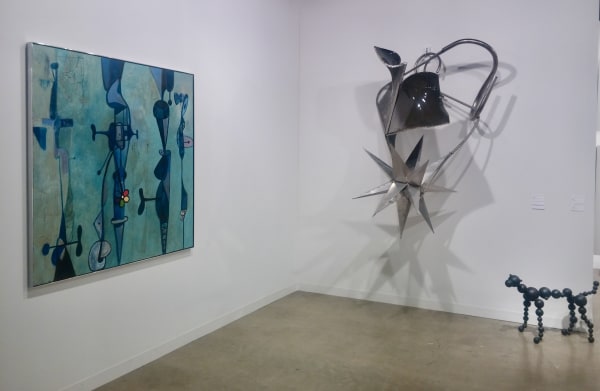
Art Basel Miami Beach
Miami Beach, Florida Dec 3 – 6, 2015John Berggruen Gallery is pleased to announce our participation in Art Basel Miami Beach. Please visit our booth D03 at the Miami Beach Convention Center.View More -

Expo Chicago
Chicago, Illinois Sep 17 – 19, 2015John Berggruen Gallery is pleased to announce our participation in the International Exposition of Contemporary & Modern Art (Expo Chicago) September 17th – 20th, 2015,...View More
-
-
-
News
-

What Sold at The Armory Show 2025
Artsy | By Maxwell Rabb and Arun Kakar September 8, 2025The Armory Show 2025 concluded on September 7th after a steady weekend of sales. The fair, which opened with its VIP day on September 4th,...Read more -

They Still Make Art in Soho: Reformed “wild man” painter John Alexander and ceramicist Fiona Waterstreet’s loft life
CURBED | By Wendy Goodman October 24, 2023Even after 44 years of living in New York City — 43 of them in this Soho loft— artist John Alexander still sounds, to this...Read more -

The Best of The Art Show 2021
White Hot Magazine | By Paul Laster November 1, 2021Presenting a lively selection of contemporary and modernist artworks by an international mix of artists, the 2021 edition of The Art Show kicked off to...Read more -

Best Group Shows of the Summer from London to the Hamptons
Cultured Magazine July 14, 2017Botánica , a new group exhibition at Berggruen Gallery, takes its name from the herbal medicine shops that once defined San Francisco's Mission district. Conceived...Read more
-
-
Publications
-
-
Inquire
Send me more information on John Alexander

